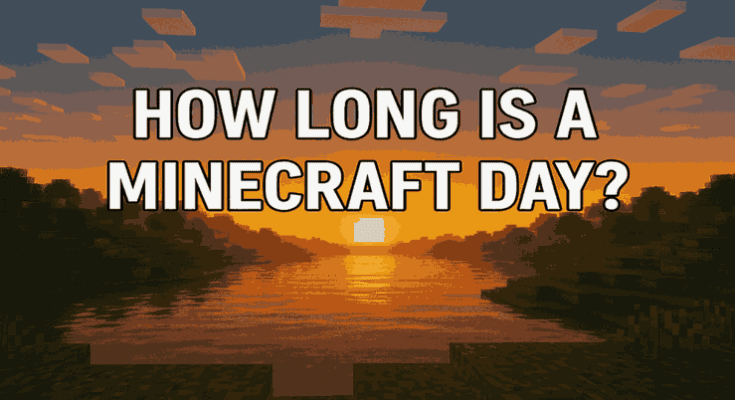If you’ve ever found yourself glancing at the Minecraft sky, wondering, “How long until nightfall?”, you’re not alone. Time in Minecraft works differently than in the real world, and understanding the in-game day cycle is crucial whether you’re farming crops, avoiding hostile mobs, or building your dream base.
In this guide, we’ll break down exactly how long a Minecraft day lasts, what happens during each phase (day, night, dawn, dusk), and how it affects your gameplay. Whether you’re a beginner trying to survive your first night or an experienced player optimizing your Redstone farms, knowing the Minecraft clock inside out gives you a real advantage.
Let’s dive into how Minecraft time works, and how long you really have before the monsters come out.
Also Read
Best Modded Minecraft Server Hosting Providers
What Is a Minecraft Day?
In Minecraft, a “day” is a complete 24,000 tick cycle that includes both daytime and nighttime. This cycle controls how the world behaves, from sunlight and mob spawning to villager routines and crop growth.
Unlike real-world time, a full Minecraft day lasts exactly 20 real-world minutes. Within that short span, the game goes through morning, noon, evening, and night, each playing a key role in your survival and strategy.
Here’s how it breaks down:
| Minecraft Time | In-Game Event | Real-Time Duration |
|---|---|---|
| 0 ticks | Sunrise begins | 0:00 (Start) |
| 1000 ticks | Daylight (Full day) | ~50 seconds |
| 6000 ticks | Noon | ~5 minutes |
| 12000 ticks | Sunset begins | ~10 minutes |
| 13000 ticks | Nighttime starts | ~10.5 minutes |
| 18000 ticks | Midnight | ~15 minutes |
| 23000 ticks | Pre-dawn | ~19.5 minutes |
| 24000 ticks | New day begins | 20:00 |
Each part of the day affects gameplay, for example, hostile mobs spawn only during low-light conditions (night and caves), and villagers follow a schedule from dawn to dusk.
How Long Is a Full Minecraft Day in Real Time?
A full Minecraft day, from one sunrise to the next, takes exactly 20 real-time minutes to complete. This 20-minute cycle includes everything: daytime, sunset, nighttime, and sunrise.
Here’s how that 20-minute span breaks down:
| Phase | Minecraft Ticks | Real-Time Duration |
|---|---|---|
| Daytime | 0–12000 | 10 minutes |
| Sunset/Dusk | 12000–13000 | 50 seconds |
| Nighttime | 13000–23000 | 7 minutes |
| Sunrise/Dawn | 23000–24000 | 50 seconds |
Why 20 Minutes?
Minecraft uses an internal clock based on “ticks”, where 1 tick = 1/20th of a second. That means:
24,000 ticks (1 full day) ÷ 20 ticks per second = 1,200 seconds
1,200 seconds ÷ 60 = 20 minutesSo, no matter how intense or peaceful your gameplay is, the sun rises and sets every 20 minutes, making time management a crucial skill — especially in survival mode.
How Long Is Each Minecraft Phase?
A full Minecraft day is divided into four main phases, each with its own distinct length and in-game characteristics. Understanding these phases can help you better plan your activities, like mining, farming, or fighting mobs.
1. Daytime (0–12000 ticks)
Real-Time Duration: 10 minutes
In-Game Description: The sun rises at 0 ticks and moves across the sky. This is the safest time to explore, build, or gather resources, as hostile mobs burn in sunlight or despawn.
2. Sunset / Dusk (12000–13000 ticks)
Real-Time Duration: 50 seconds
In-Game Description: The sky begins to darken, and the sun sets. Mobs will start to spawn soon, so this is a good time to head indoors or prepare for nightfall.
3. Nighttime (13000–23000 ticks)
Real-Time Duration: 7 minutes
In-Game Description: The moon rises, and hostile mobs like zombies, skeletons, and creepers roam freely. Without proper lighting or shelter, survival becomes more challenging.
4. Sunrise / Dawn (23000–24000 ticks)
Real-Time Duration: 50 seconds
In-Game Description: The sky brightens, mobs start to burn or despawn, and a new day begins. Great time to start your morning tasks!
Fun Fact: If you’re in a bed during nighttime, you can skip from night directly to morning, essentially fast-forwarding time in the game.
How Long Is a Minecraft Hour?
In Minecraft, time moves much faster than in real life. A full Minecraft day is 20 minutes long, and it’s divided into 24 hours, just like in the real world. This means each Minecraft hour is quite short in real-time.
Minecraft Hour Calculation
1 full Minecraft day = 20 real-world minutes
20 minutes ÷ 24 hours = 50 seconds per Minecraft hour
✅ So, one Minecraft hour equals just 50 real-life seconds.
What This Means for You
Crops grow quickly.
Smelting, brewing, and other timed processes feel faster.
Events like sunrise, sunset, and mob spawns happen rapidly — so timing is key!
This fast-paced clock helps keep gameplay engaging without making you wait too long for day-night cycles to repeat.
How to Track Time in Minecraft
Minecraft doesn’t have a visible in-game clock by default, but there are several ways to know what time it is without guessing.
1. Use a Clock Item
Minecraft has a built-in item called a Clock that shows the position of the sun and moon.
Crafting recipe: 1 Redstone + 4 Gold Ingots
How it works: The clock face shifts between day (sun) and night (moon), helping you avoid stepping outside during mob-infested hours.
📝 Tip: Clocks are most useful when you’re underground or inside and can’t see the sky.
2. Observe the Sky
When you’re above ground, just look up!
Sun rising in the east = Morning
Sun overhead = Noon
Sun setting in the west = Evening
Moon appearing = Nighttime has started
3. Use Redstone Timers
If you’re into Redstone automation, you can create simple or complex circuits to:
Trigger events at specific times
Simulate real-time clocks
Automate doors, farms, and lights
4. Use Commands (Creative/Operator Mode)
In creative or operator-enabled worlds, run this command to check the in-game time
/time query daytimeReturns a tick value between
0and23999For example,
0is sunrise,6000is noon,12000is sunset,18000is midnight
Why Time Matters in Minecraft Gameplay
Time in Minecraft isn’t just decorative; it directly impacts your survival, strategy, and exploration.
1. Mob Spawning and Safety
Hostile mobs like zombies, skeletons, and creepers spawn at night or in dark areas.
You’re safest during the day when these mobs burn in sunlight.
Planning your mining, building, or exploring during daytime minimizes danger.
🔒 Pro Tip: Always carry a bed to sleep through night cycles if you’re not ready for combat.
2. Farming and Crop Growth
Crops grow based on random tick speed, which is influenced by time passing.
Having a full day-night cycle helps simulate more realistic growth and makes automation timing easier.
3. Mining and Resource Gathering
Mining is safer at night since you’re underground.
Use night time to gather resources below and daytime to work above ground.
4. Villager Schedules
Villagers follow a strict schedule:
Work during the day
Return home at sunset
Sleep at night
This affects trading windows and iron golem spawns.
5. Redstone and Event Timing
Redstone contraptions like farms, mob grinders, and lights can be optimized based on time of day.
Some players build clocks that sync with in-game time to automate these processes.
How to Change the Time in Minecraft (With Commands)
Changing the time in Minecraft can help you skip dangerous nights, test builds, or reset mob behavior, especially useful in Creative or Cheats-enabled Survival mode.
🎯 Basic Time Command Format
Use the /time set command in the in-game chat. You must have cheats enabled or be in Creative Mode.
/time set Common Time Values
| Time of Day | Command | In-Game Description |
|---|---|---|
| Day | /time set day | Sets time to 1000 (Morning) |
| Noon | /time set noon | Brightest part of the day |
| Night | /time set night | Sets time to 13000 (Nightfall) |
| Midnight | /time set midnight | Deep night (18000) |
0 = Dawn
6000 = Noon
12000 = Dusk
18000 = Midnight
Advancing Time
To move time forward without resetting the day:
/time add 1000This adds 1,000 ticks (roughly 1 minute in real time).
Why Minecraft Day Length Matters
Understanding the Minecraft day-night cycle isn’t just fun trivia; it’s key to survival, resource planning, and efficient gameplay. Here’s why timing your activities around the in-game clock really matters:
1. Mob Spawning
Hostile mobs like zombies, skeletons, and creepers only spawn in darkness—usually during:
Night (13000–23000 ticks)
Caves or shadowy areas
💡 Plan your mining or outdoor adventures during the day to avoid unnecessary fights.
2. Farming & Villager Behavior
Crops grow faster in sunlight.
Villagers stick to a daily schedule: working by day, sleeping at night.
If you run a villager-based trading hall, maximize productivity during daylight hours.
3. Building & Exploration Safety
Daytime is the safest time to:
Explore caves or distant biomes
Build large structures without being attacked
Scout without fear of surprise creepers
Use your time wisely; build by day, defend by night.
4. Redstone Timers & Automation
Some redstone contraptions rely on daylight sensors or tick-based timers.
For example, automatic doors or lighting systems can trigger based on sunrise/sunset.
Farms can harvest during daylight to avoid mob interference.
5. Speedrunning & Event Triggers
If you’re speedrunning or using in-game events:
Certain events (e.g., phantoms, raids) are time-sensitive.
Sleeping through night can alter game mechanics or event triggers.
How to Speed Up or Change the Day-Night Cycle
Sometimes, the default 20-minute Minecraft day cycle may not suit your gameplay style. Whether you’re building in peace, running a server, or creating an adventure map, you can customize or even control the time using these methods:
1. Use Commands
Minecraft offers built-in commands to change the time of day instantly.
| Time of Day | Command |
|---|---|
| Day | /time set day |
| Noon | /time set noon |
| Night | /time set night |
| Midnight | /time set midnight |
| Custom Time (e.g., 6000 ticks) | /time set 6000 |
2. Use Game Rules
You can stop the day-night cycle completely using:
/gamerule doDaylightCycle false💡 Want the sun to stay at noon forever? Use this with /time set noon.
To re-enable the cycle:
/gamerule doDaylightCycle true3. Modify Game Ticks (Advanced)
Using data packs, server mods (like Bukkit or Spigot), or Forge mods, server admins can:
Speed up or slow down the tick rate
Customize day and night length separately
Automate day-night transitions for events or role-play
Example Mods:
Time Control (Forge)
EssentialsX for Bukkit servers (
/time&/daycommand enhancements)
4. Sleep to Skip the Night
Sleeping in a bed skips from night to day, resetting the cycle back to 0 ticks (start of a new day). This is the default way to avoid nighttime threats in Survival mode.
As of Minecraft 1.15+, only a percentage of players need to sleep to skip night on multiplayer servers.
Conclusion
Understanding the Minecraft day-night cycle helps you play smarter, whether you’re farming, fighting mobs, or exploring. A full day in Minecraft takes just 20 minutes in real time, with each phase having a purpose. Knowing how long daylight lasts can help you time your builds and travel safely, while preparing for the dangers that come with night.
Whether you’re a new player or a seasoned builder, managing your time in Minecraft is just as important as gathering resources. Now that you know how long a Minecraft day is, and how it breaks down, you’re ready to thrive in any world you create.
FAQs: How Long Is A Minecraft Day?
1. Can you skip night in Minecraft?
Yes! If all players sleep at the same time (or a majority on multiplayer), the night skips instantly. This also resets phantom spawn timers.
2. What happens if you don’t sleep for multiple nights?
After 3 Minecraft days (about 1 real hour) without sleep, phantoms will spawn at night and attack you from the skies. Sleeping resets this timer.
3. How many Minecraft days are in a real day?
Since each Minecraft day is 20 minutes, you can fit: 72 Minecraft days in 24 real-life hours.




